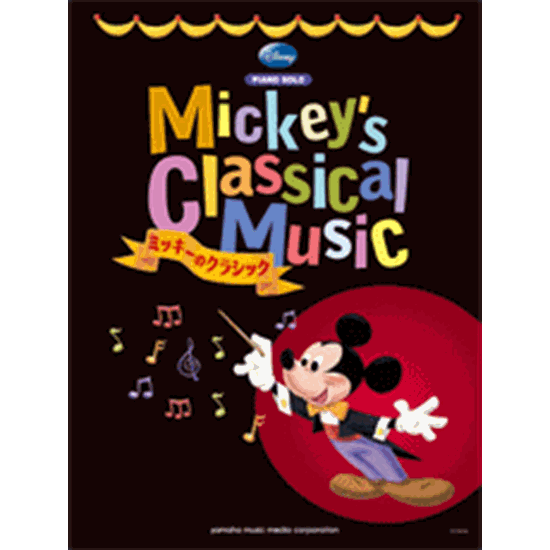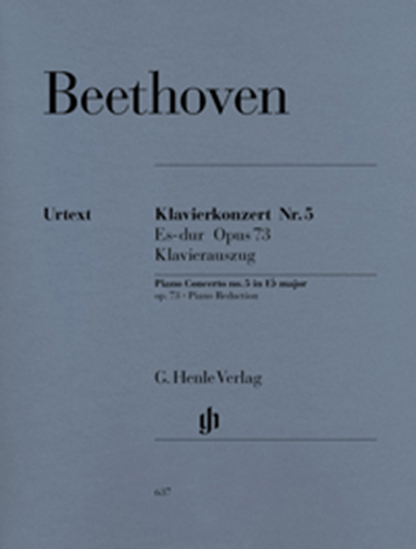Beethoven, Ludwig van : Konzert für Klavier und Orchester Nr.5 Es-Dur Op.73
Work Overview
Publication Year:1811
Dedicated to:Rudolf Johannes Joseph Rainer, Erzherzog von Österreich
Instrumentation:Concerto
Genre:concerto
Total Playing Time:37 min 00 sec
Copyright:Public Domain
Commentary (2)
Author : PTNA Piano Encyclopedia Editorial Department
Last Updated: January 1, 2010
[Open]
Author : PTNA Piano Encyclopedia Editorial Department
The period of about a dozen years from around 1800 marks Beethoven's middle period, a peak of his creative output, during which masterpieces and large-scale works were successively composed, including Symphony No. 3 "Eroica," No. 5 "Fate," and No. 6 "Pastoral"; the three "Razumovsky" String Quartets; the "Archduke" Trio; Piano Sonatas "Waldstein", "Appassionata", and "Les Adieux"; Piano Concerto No. 4; and the Violin Concerto.
This Piano Concerto No. 5 also reflects the magnitude of Beethoven's creative drive, resulting in a colossal and powerful work. The alternative title of this work, "Emperor," was not given by Beethoven himself but by his publisher, J.B. Cramer.
The premiere took place on November 28, 1811, at the Gewandhaus in Leipzig, with J.F. Schneider as the soloist. Furthermore, the following year, it was performed in Vienna with Carl Czerny, Beethoven's pupil and renowned for his piano etudes, as the soloist.
I. Allegro, E-flat major, 4/4 time
The movement is written in concerto-sonata form. While Piano Concerto No. 4 introduced the novel approach of beginning with the solo piano, No. 5 immediately follows the orchestra's powerful tonic chord with a brilliant, cadenza-like passage from the piano. Although this is merely an introduction and not a theme, it is followed by the dignified first theme and the second theme, initially played in a minor key, which develop energetically.
II. Adagio un poco mosso, B major, 4/4 time
A gentle, beautiful, and tranquil slow movement, written in a free variation form. Amidst the brilliant movements preceding and following it, a simple yet profound music unfolds softly. It concludes by transitioning to E-flat major, where the theme of the third movement is slowly introduced, leading directly into the final movement without a break.
III. Allegro, E-flat major, 6/8 time
The theme introduced in the preceding movement begins explosively at forte, forming a rondo-sonata form. A magnificent and powerful, brilliant finale.
Author : Tetsu, Yurina
Last Updated: October 6, 2019
[Open]
Author : Tetsu, Yurina
The nickname "Emperor" was popularized by Johann Baptist Cramer and was not given by Beethoven himself. It was composed between 1808 and 1809, a period when Emperor Napoleon was successively invading Europe. Vienna, where Beethoven lived, was also attacked by French forces and occupied in May 1809. Beethoven, who remained in Vienna without evacuating, continued his composition amidst the torment of French bombardment. It can be said that the work was composed in a spirit diametrically opposed to the glorification of the emperor.
Originally, the concerto genre, requiring a large number of performers, had fewer opportunities for live performance compared to solo pieces. Therefore, it necessitated a certain showmanship to immediately captivate the audience and was composed in already established popular styles to be widely accepted. Beethoven broke with this convention, composing this Fifth Concerto with profound inner spirituality and incorporating a forward-looking compositional style.
The premiere (private) took place on January 13, 1811, at the Lobkowitz Palace in Vienna, with Schulz conducting and Archduke Rudolf (Beethoven's esteemed pupil and patron) as soloist. For public performances, it was played on November 28, 1811, at the Gewandhaus in Leipzig with Friedrich Schneider as soloist, and on February 12, 1812, at the Kärntnertor Theater in Vienna with Carl Czerny as soloist. Perhaps the era could not keep pace with Beethoven, as these performances were unsuccessful. Later, Franz Liszt frequently performed it in concerts, making it a popular work.[1]
First Movement
Allegro E-flat major 4/4 time
A large-scale movement that, while adhering to the concerto-sonata form, incorporates many innovative ideas. The cadenza-like introduction by the solo piano is woven in as if in confrontation with the full orchestral tutti. From bar 11, the orchestra begins the majestic first theme, and plays the second theme in the parallel major (from bar 41) and the tonic key (from bar 49). After a transition based on the material of the first theme (from bar 57), a contrapuntal codetta (from bar 78) leads to the appearance of the solo instrument. The first theme played by the piano solo is transformed into a gentle melody with ornamental variations, and the second theme, played by the piano solo in the high register, evokes a purified, celestial sound. The descending figuration of the piano solo appearing in the transition section (from bar 217) also possesses a purity reminiscent of the sound of a clear stream. The heroic character seen at the beginning reappears at the climax of the development section (from bar 304), where one might perceive Beethoven's rebellious and anti-war spirit. In the piano solo just before the recapitulation, a prayer ascends to heaven and fades away.
Second Movement
Adagio un poco mosso B major 4/4 time
Ternary form. The main section is imbued with an all-encompassing magnanimity and a reverent sound. It begins with muted strings (the strings play with mutes throughout this second movement), and at bar 9, as the volume increases, wind instruments join in. The piano makes its first appearance in the middle section from bar 16, presenting a smooth and beautiful descending figuration.
In the recapitulation (from bar 45), the strings switch to pizzicato, and the piano takes the lead, driving the music forward. And then, a highly impressive passage... the transition to the third movement. At bar 79, the bassoon meaningfully sustains the tonic H, and at bar 80, the horn takes over on B-flat, a semitone lower. The piano, drawn into E-flat major by that B-flat, plays the theme of the third movement in a dreamy and fantastical manner.
Third Movement
Rondo Allegro - Piu allegro E-flat major 6/8 time
Rondo-sonata form. Waking from a dream, the piano plays the lively main theme, and the orchestra takes over, playing the main theme with jubilation. Maintaining that momentum, a virtuosic piano solo enters (bar 42) and ascends. After reaching the peak in the high register, the tension smoothly resolves with a dim., and a gentle, mellow musical idea marked dolce appears (bar 49). At bar 72, a new musical idea appears again with dolce, and at bar 78, dolce is written in once more. This musical idea (from bar 72), being in the dominant key of B-flat major, does not have a particularly prominent thematic character, but has traditionally been interpreted as a subordinate theme. The author interprets the entire section from approximately bars 49 to 93 as a group of subordinate themes, given the persistent notation of "dolce" three times in this vicinity and the distinctive character of the musical idea from bar 49. Thereafter, the main theme is played with various expressive nuances, and the movement concludes with a brilliant flourish.
[1] The musical examples in this commentary use the old complete edition by Breitkopf.
Movements (3)
Arrangements & Related Works(1) <Show>
PTNA & Partner Channel Videos(18items) View More
- favorite_border
- 4
Recording Date: 2010/8/22
Recording Location: 第一生命ホール(2010年ピティナ・ピアノコンペティション 特級 ファイナル)
- favorite_border
- 0
Recording Date: 2010/8/22
Recording Location: 第一生命ホール(2010年ピティナ・ピアノコンペティション 特級 ファイナル)
- favorite_border
- 1
Recording Date: 2000/1/23
Recording Location: 吹田市交響楽団定期演奏会 指揮・米山信 ピアノ:スタインウェイ
- favorite_border
- 1
Recording Date: 2021/3/27
Recording Location: ミュ-ジックカフェ アンジェス(独奏ピアノ)&大分県立芸術文化短期大学 研究室(オーケストラパート:リスト編曲)
- favorite_border
- 0
Recording Date: 2000/1/23
Recording Location: 吹田市交響楽団定期演奏会 指揮・米山信 ピアノ:スタインウェイ
- favorite_border
- 0
Recording Date: 2014/8/21
Recording Location: 第一生命ホール(2014年ピティナ・ピアノコンペティション 特級 ファイナル)
- favorite_border
- 0
Recording Date: 2014/8/21
Recording Location: 第一生命ホール(2014年ピティナ・ピアノコンペティション 特級 ファイナル)
Sheet Music
Scores List (11)

(株)ヤマハミュージックエンタテインメントホールディングス

(株)リットーミュージック

(株)ヤマハミュージックエンタテインメントホールディングス

(株)リットーミュージック

日本楽譜出版社

(株)ヤマハミュージックエンタテインメントホールディングス

KMP(ケイ・エム・ピー) ケイエムピー

(株)ヤマハミュージックエンタテインメントホールディングス

(株)ヤマハミュージックエンタテインメントホールディングス














